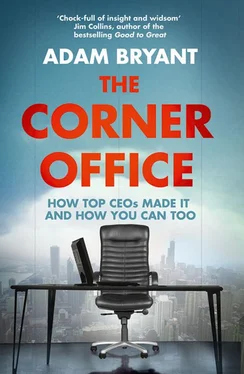“It was a lot of responsibility, and I guess it was a sort of sink-or-swim moment,” she said. “I had to lead that group, and it was complicated by the fact that it was multinational, so at its peak I think I was dealing with eleven or twelve nationalities. We were probably about thirty to thirty-five people. It was constantly focusing on teamwork. The way we did it was just being really rigorous about routine and, in some ways, not that flexible, so people really knew what the ground rules were. One example – and it seems so matronly now that I look back on it – was that the team had to be in the lobby at the hotel, ready to go to work, at whatever the designated time was. If they weren’t there, the bus leaves. You get to the airport yourself. If we were in Tunisia, that meant finding a bike and cycling across the desert to get to the airport. When I first got to the field, you would have the nurses, engineers, whoever, waiting, and you would maybe have one who just couldn’t drag himself out of bed and everybody’s waiting. We saw behaviors change fairly rapidly. So we had a fairly tight routine, and we made announcements every morning. It was just important to let everybody know what was coming.”
Sharon Napier, the CEO of the advertising agency Partners + Napier, played basketball in high school and college, and she uses sports analogies constantly with her staff to drive home messages, including the notion that people have roles to play, that the team’s success is what matters most.
“I went from playing high school basketball to college basketball,” she said. “You can be a star in high school, and you can be the ninth player in college. It’s just the way it is. So I always talk about understanding the bench strength. First of all, every player has a role. Know what it is. If you’re the seventh player who’s supposed to go in and get five rebounds because we need them, that’s your role. So I talk about that a lot – we don’t have the starting team and the not-starting team. We have a bench, and everybody has to be strong. They come in and they bring different things to the table. And you learn that by playing. You learn that if you’re not worried about your own success, and you’re worried about the success of the team, you go a lot further.”
Perhaps one of the simplest ways to think about teamwork is to forget or organization al charts and titles. Companies increasingly operate through ad hoc teams, formed and disbanded to accomplish various tasks. Team smarts refers to this ability to recognize the type of players the team needs, and how to bring them together around a common goal. Susan Lyne, the CEO of Gilt Groupe, said the ultimate test of team smarts today is being able to bring together a group of people, including those who don’t report directly to you. Lyne described how she grew to appreciate team players, and what they can and should bring to the table.
“I think that now I have a very strong antenna for someone who is going to be poison within a company,” she said. “I think that early on, I was wowed by talent, and I was willing to set aside the idea that this person might not be a team player. Now, somebody needs to be able to work with people – that’s number one on the list. I need people who are going to be able to build a team, manage a team, recruit well, and work well with their peers. And that’s another thing you learn over time. Somebody may be a great manager of a team, but incapable of working across the company to get things done because they’re competitive, or because of any number of reasons. Can they manage down? Can they work across the company and get people to want to work with them and to help them succeed? And are they going to keep you well informed of everything that’s going on?”
Lyne said this skill is so crucial today that business schools should be teaching it in more courses.
“There are a lot of great courses on managing or developing a strategic agenda, but there is very little about how to work with your peers where you need to get X done, and you need these other three departments to give you X amount of time in order to succeed at that. The people who truly succeed in business are the ones who actually have figured out how to mobilize people who are not their direct reports. Everyone can get their direct reports to work for them, but getting people who do not have to give you their time to engage and to support you and to want you to succeed is something that is sorely missing from B-school courses.”
Chapter 4
A SIMPLE MINDSET
Here’s ahypothetical test that can speed the process of identifying who has what it takes to move up in an organization.
Imagine giving one hundred vice presidents the same task: take a month to search out a new business opportunity for their company, and then present the idea to a group of senior executives during a weekend off-site meeting. The month passes, they have their ideas, and the day arrives to start their presentations.
The ideas are all pretty good, but the presentations vary enormously in length. One by one, the young vice presidents come in. Some want to take forty-five minutes, using a thirty-slide Power-Point deck to pitch their idea. Other presentations are shorter, with only ten slides. Still others have three slides or even two, and they’re done in five minutes or less. One person doesn’t use Power-Point at all. She simply talks, giving a short pitch for her idea, backed up with three key facts.
The executives are impressed by how concise she was, the simplicity of the idea, and that she respected their time. Later, she gets a call. The executives want to sign her up for the company’s leadership development program for high-potential employees.
There is a stubborn disconnect in many companies. By all accounts, CEOs – and most senior executives – want the same thing from people who present to them: be concise, be brief, get to the point, make it simple. Business is not always as complicated as it sometimes appears to be, nor should it be.
“I’ve tried to do less of the things that make business more complex,” said Eduardo Castro-Wright, a vice chairman at Wal-Mart Stores. “I really like simplicity. At the end of the day, retailing – though you could apply this to many other businesses – is not as complicated as we would like to make it. It is pretty logical and simple, if you think about the way that you yourself would act, or do act, as a customer.”
Yet few people can deliver the simplicity that many bosses want. Instead, they mistakenly assume the bosses will be impressed by a long PowerPoint presentation that shows how diligently they researched a topic, or that they will win over their superiors by talking more, not less.
Few things seem to get CEOs riled up more than lengthy PowerPoint presentations. It’s not the software they dislike – it’s just a tool, after all. What irks them is the unfocused thinking that leads to an overlong slide presentation. There is wide agreement it’s a problem—“Death by PowerPoint” has become a cliché.
If so many executives in positions of authority are clear about what they want, why can’t they get the people who report to them to lose the “Power” part of their presentations and simply get to the “Point”?
There are a few likely explanations. The first is that a lot of people have trouble being concise. Next time you’re in a meeting, ask somebody to give you the ten-word summary of his or her idea. Some people can do a quick bit of mental jujitsu, and they’ll summarize an idea with a “Here’s what’s important. ” or “The bottom line is. ” Even if they take twenty-five words, they at least understand what’s being asked of them.
Others will pause for a moment and then launch into a lengthy discussion of the idea, because they have trouble identifying the core point. Granted, it’s not easy – a point that’s been captured in many sayings through the ages. “Simplicity is the ultimate sophistication,” said Leonardo da Vinci. And in words attributed to Mark Twain (and many others), “I didn’t have time to write a short letter, so I wrote a long one instead.”
Читать дальше












